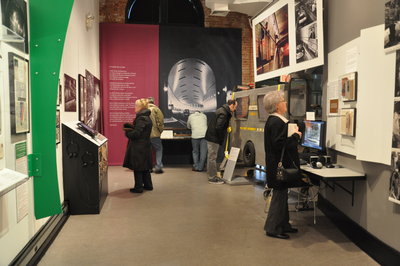The Holland and Lincoln tunnels, which bookend Hoboken, are the subject of a six-month exhibit at the Hoboken Historical Museum called “Driving Under the Hudson – A History of the Holland and Lincoln Tunnels.”
In 2012, the Holland Tunnel in Jersey City turns 85 years old, while the Lincoln Tunnel is turning 75. David Webster, the collections manager at the museum, thought this year would be the perfect time to put on the exhibit.
The museum displays two six-month exhibits per year. The staff of workers and volunteers at the museum takes several months to organize and prepare each exhibit.
“It varies on the exhibit, but this one took about three months,” Webster said. “Then, physically installing the exhibit takes about a month.”
Hoboken to Manhattan Bridge?
The display includes other historical facts about regional transportation. One portion of the exhibit highlights planning for a former proposed bridge from uptown Hoboken to Manhattan that was scheduled to be built in the late 1890s.
“The bridge would have been twice the size of the Brooklyn Bridge, but it would have obliterated uptown Hoboken [because of the traffic],” Webster said. “It was supposed to be a railroad bridge but the railroad company couldn’t raise the funds…the railroad tunnel [which was later built through North Bergen] was a much cheaper way to fulfill their needs.”
On display at the museum is the original 500-pound, granite, carved cornerstone from the proposed bridge.
Although the Lincoln and Holland tunnels are not as glamorous as bridges throughout the area, Webster said the tunnels “are as important to our region as any of the bridges.”
“The tunnels are often taken for granted,” Webster said. “We use them all the time, and they don’t have the nice granite entrance designs except in Weehawken. A lot of people don’t realize that it took a significant amount of innovative engineering to make them happen.”
Despite the improvements in architectural technology, Webster said that modern tunnels are built with essentially the same tools.
“It’s more sophisticated with electronics but it’s generally the same types of devices that are used to drill today,” Webster said. “It’s quite surprising.”
Construction on the Holland Tunnel began in 1920, and it took seven years to build, opening in 1927.
The Lincoln Tunnel’s two tubes opened in 1937, and by 1957 there was a third tube built.
“Workers would ride along the rails inside the tube.” – David Webster
____________
Impact on Hoboken
Webster said that companies like Maxwell House and Tootsie Roll probably would not have come to Hoboken or stayed there if it wasn’t for the tunnels, which provide unfettered access to Manhattan.
“As we point out, Forbes recently named [Hoboken] the number one city for urban transportation,” Webster said. “We also have the ferries and the PATH trains that go out of Hoboken, but going by car and bus due to the tunnels has made Hoboken a significantly better place over the short and long term.”
As part of the display, the museum also has a catwalk cart from the Port Authority that was used in the Lincoln Tunnel.
“It was in use last year and it’s going to be replaced, but it’s the kind of thing that helped them monitor the traffic flow and help keep track of emergencies in the tunnel,” he said. “Workers would ride along the rails inside the tube.”
The exhibit will be on display until July 1.
Last year, the museum was in its 10th year of a 100-year lease at 1301 Hudson St. from Hoboken-based developers Applied Housing. The rent for the museum is $1 per year. Applied is also a prominent sponsor of the museum.
Museum Executive Director Robert Foster said the museum sees approximately 80 guests on an average Sunday, the busiest day of the week. Admission is a $2 donation that helps keep the museum operating.
For more information about the display and the museum, visit www.hobokenmuseum.org.
Three ‘Tunnel Talks’ to help you ‘dig’ into tunnel lore
Sun., Apr. 15, 4 p.m., Tunnel talk: Hudson County historian John Gomez will discuss the architectural significance of the Holland Tunnel ventilation towers.
Sun., May 20, 4 p.m., Tunnel talk: “Highway Under the Hudson” author Dr. Robert W. Jackson will describe the conditions that precipitated the construction of the Holland Tunnel, and its impact since then.
Sun., Jun. 24, 4 p.m., Tunnel talk: “The Last Three Miles” author Steven Hart will discuss the riveting saga of the roads and bridges connecting the Holland Tunnel to the rest of the country.
Ray Smith may be reached at RSmith@hudsonreporter.com.
